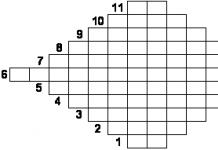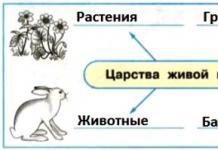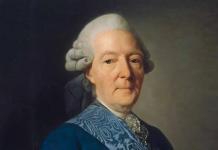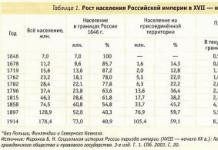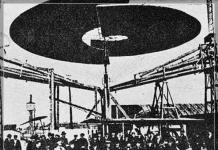The rate of enzymatic reactions can be partially reduced or completely blocked by certain substances, so-called enzyme inhibitors. Some enzyme inhibitors are effective medicinal substances for the organism of animals and humans, others are deadly poisons.
Reversible inhibitors
There are three types of reversible enzyme inhibition: competitive, noncompetitive, and noncompetitive.
Competitive called an inhibitor that reversibly interacts with the active site of the enzyme. As a rule, competitive inhibitors are similar in structure to the substrate and can be displaced from the enzyme-inhibitor complex by an excess of the substrate. Interaction with a competitive inhibitor does not lead to denaturation or inactivation of the enzyme; therefore, when the inhibitor is replaced by a substrate, the rate of the enzymatic reaction does not decrease (Fig. 6.Yu).
When an enzyme interacts with a competitive inhibitor, the value K m corresponding enzymatic reaction.
The similarity of the substrate and competitive inhibitor is sufficient for interaction and the formation of an enzyme-inhibitor complex, but not enough for an enzymatic reaction. An example is the effect of malonic acid on the reaction catalyzed by succinate dehydrogenase and associated with the conversion of succinic acid to fumaric acid.

Rice. 6.10.
The addition of malonic acid to the reaction mixture reduces or completely stops the enzymatic reaction, since it is a competitive inhibitor of succinate dehydrogenase.

The similarity of malonic acid with succinic acid is sufficient for the formation of a complex with the enzyme, but the decomposition of this complex does not occur. With an increase in the concentration of succinic acid, it displaces malonic acid from the complex, as a result, the activity of succinate dehydrogenase is restored.
Many medicinal substances inhibit human and animal enzymes in a competitive manner. An example is sulfa drugs, which are similar in structure to l-aminobenzoic acid (PABA). This compound in microbial cells is an intermediate of folic acid, an important component of nucleic metabolism. With the introduction of sulfa drugs into the body, the enzymes of PABA metabolism are inhibited, which leads to a decrease in the synthesis of nucleic acids and the death of the microorganism.

In this case, sulfanilamide is a competitive inhibitor of the enzyme folic acid synthesis.
The peptoglycan structure of the bacterial cell wall includes D-alanine, which is absent in animals and humans. To synthesize the cell wall, bacteria use the enzyme alanine-racemase to convert animal L-alanine into the D-form. Alanine racemase is characteristic of bacteria and has not been found in mammals. Therefore, it is a good target for drug inhibition. Substitution of one of the protons of the methyl group for fluorine gives fluoroalanine, to which alanine-racemase binds, which leads to its inhibition.

Thus, it is possible to design medicinal substances that inhibit enzymes in a competitive manner. To be effective, an inhibitor must have a high affinity for the enzyme. Otherwise, it is necessary to prescribe large doses of drugs in order to actively compete with the endogenous substrate for the active site of the enzyme.
Non-competitive inhibitors interact with enzymes not in the region of the active center, but at some distance from it, and they are not removed from the complex by any excess of the substrate. When an inhibitor interacts with an enzyme, its conformation changes, followed by partial disintegration of the active site. When an enzyme interacts with a non-competitive inhibitor, the enzymatic reaction changes.
Unrivaled inhibition occurs when the inhibitor interacts with the enzyme only as part of the enzyme-substrate complex, preventing its degradation. An example of the irreversible action of inhibitors on enzymes can be organophosphorus substances used as insecticides.

Rice. 6.11. Lineweavesra-Burk plot to identify different types of inhibition: but- competitive inhibition; b- non-competitive inhibition
The type of inhibition can be determined graphically using the Lineweaver-Burk or Edie-Hofstee methods (Figure 6.11).
As can be seen from fig. 6.11, the effect of a competitive inhibitor on the reaction rate leads to a change in /G m, while the maximum reaction rate remains unchanged. Uncompetitive inhibition is associated with a decrease V max , without changing the Mechaelis constant.
The activity of many enzymes is inhibited by an excess of substrate, and there are several mechanisms for this process.
- If several functional groups of the enzyme are involved in the formation of the enzyme-substrate complex, then two or more substrates can be simultaneously attached to the active center, which unambiguously leads to the formation of an inactive complex.
- In the case of an excess of the substrate, it can be attached not only to the active center, but also to other chemical groups functionally associated with the active center. This kind of interaction can interfere with the enzymatic reaction.
- An increase in the substrate concentration can increase the ionic strength of the reaction medium and, consequently, slow down the rate of the enzymatic reaction.
The inhibition of the reaction products is due to the fact that they can bind to the enzyme or to some other component of the system in such a way that the rate of the direct reaction decreases.
All biochemical reactions occurring in the body are subject to specific control, which is carried out through an activating or inhibitory effect on regulatory enzymes. The latter are usually at the beginning of chains of metabolic transformations and either start a multi-stage process or slow it down. Some single reactions are also subject to regulation. Competitive inhibition is one of the main mechanisms for controlling the catalytic activity of enzymes.
What is inhibition?
The mechanism of enzymatic catalysis is based on the binding of the active site of the enzyme to the substrate molecule (ES complex), resulting in a chemical reaction with the formation and release of the product (E+S = ES = EP = E+P).
Enzyme inhibition is a reduction in the rate or complete stop of the catalysis process. In a narrower sense, this term means a decrease in the affinity of the active center for the substrate, which is achieved by binding enzyme molecules to inhibitor substances. The latter can act in various ways, on the basis of which they are divided into several types, which correspond to the inhibition mechanisms of the same name.
Main types of inhibition
According to the nature of the process, inhibition can be of two types:
- irreversible- causes persistent changes in the enzyme molecule, depriving it of functional activity (the latter cannot be restored). It can be either specific or non-specific. The inhibitor binds strongly to the enzyme by covalent interaction.
- reversible- the main type of negative regulation of enzymes. It is carried out due to the reversible specific attachment of the inhibitor to the protein-enzyme by weak non-covalent bonds, amenable to kinetic description according to the Michaelis-Menten equation (with the exception of allosteric regulation).
There are two main types of reversible enzyme inhibition: competitive (can be weakened by increasing the concentration of the substrate) and non-competitive. In the latter case, the maximum possible rate of catalysis decreases.
The main difference between competitive and non-competitive inhibition lies in the site of attachment of the regulatory substance to the enzyme. In the first case, the inhibitor binds directly to the active site, and in the second, to another site of the enzyme, or to the enzyme-substrate complex.
There is also a mixed type of inhibition, in which binding to an inhibitor does not prevent the formation of ES, but slows down catalysis. In this case, the regulator substance is in the composition of double or triple complexes (EI and EIS). In the uncompetitive type, the enzyme only binds to ES.
Features of reversible competitive inhibition of enzymes
The competitive mechanism of inhibition is based on the structural similarity of the regulatory substance with the substrate. As a result, a complex of the active site with the inhibitor is formed, conventionally designated as EI.
Reversible competitive inhibition has the following features:
- binding to the inhibitor occurs at the active site;
- inactivation of the enzyme molecule is reversible;
- the inhibitory effect can be reduced by increasing the concentration of the substrate;
- the inhibitor does not affect the maximum rate of enzymatic catalysis;
- the EI complex can decompose, which is characterized by a corresponding dissociation constant.
With this type of regulation, the inhibitor and the substrate seem to compete (compete) with each other for a place in the active center, from where the name of the process comes from.

As a result, competitive inhibition can be defined as a reversible process of inhibition of enzymatic catalysis based on the specific affinity of the active site for the inhibitor substance.
Mechanism of action
The binding of the inhibitor to the active site prevents the formation of the enzyme-substrate complex required for catalysis. As a result, the enzyme molecule becomes inactive. Nevertheless, the catalytic center can bind not only to the inhibitor, but also to the substrate. The probability of formation of one or another complex depends on the ratio of concentrations. If there are significantly more substrate molecules, then the enzyme will react with them more often than with the inhibitor.

Influence on the rate of a chemical reaction
The degree of inhibition of catalysis during competitive inhibition is determined by the amount of enzyme that will form EI complexes. In this case, it is possible to increase the concentration of the substrate to such an extent that the role of the inhibitor will be replaced, and the catalysis rate will reach the maximum possible value corresponding to the value of V max according to the Michaelis-Menten equation.
This phenomenon is explained by a strong dilution of the inhibitor. As a result, the probability of enzyme molecules binding to it is reduced to zero, and active centers react only with the substrate.
Kinetic dependences of the enzymatic reaction with the participation of a competitive inhibitor
Competitive inhibition increases the Michaelis constant (Km), which is equal to the substrate concentration required to achieve ½ of the maximum rate of catalysis at the start of the reaction. The amount of the enzyme hypothetically able to bind to the substrate remains constant, while the number of actually formed ES complexes depends only on the concentration of the latter (EI complexes are not constant and can be displaced by the substrate).
Competitive inhibition of enzymes can be easily determined from kinetic dependence plots plotted for different substrate concentrations. In this case, the value of K m will change, and V max will remain constant.

In noncompetitive inhibition, the opposite is true: the inhibitor binds outside the active site, and the presence of the substrate cannot affect this in any way. As a result, some of the enzyme molecules are “turned off” from catalysis, and the maximum possible rate decreases. Nevertheless, active enzyme molecules can easily bind to the substrate both at low and at high concentrations of the latter. Therefore, the Michaelis constant remains constant.

Graphs of competitive inhibition in the system of double inverse coordinates are several straight lines intersecting the y-axis at the point 1/V max . Each straight line corresponds to a certain concentration of the substrate. Different points of intersection with the abscissa axis (1/[S]) indicate a change in the Michaelis constant.
The action of a competitive inhibitor on the example of malonate
A typical example of competitive inhibition is the process of reducing the activity of succinate dehydrogenase, an enzyme that catalyzes the oxidation of succinic acid (succinate) to fumaric acid. The inhibitor here is malonate, which is structurally similar to succinate.

The addition of an inhibitor to the medium causes the formation of complexes of malonate with succinate dehydrogenase. Such a bond does not cause damage to the active site, but blocks its accessibility to succinic acid. Increasing the concentration of succinate reduces the inhibitory effect.

Use in medicine
The mechanism of competitive inhibition is the basis for the action of many drugs, which are structural analogues of the substrates of some metabolic pathways, the inhibition of which is a necessary part of the treatment of diseases.
For example, to improve the conduction of nerve impulses in muscular dystrophies, it is required to increase the level of acetylcholine. This is achieved by inhibiting the activity of its hydrolyzing acetylcholinesterase. Quaternary ammonium bases that are part of drugs (proresin, endrophonium, etc.) act as inhibitors.
In a special group, antimetabolites are distinguished, which, in addition to the inhibitory effect, exhibit the properties of a pseudosubstrate. In this case, the formation of the EI complex leads to the formation of a biologically inert anomalous product. Antimetabolites include sulfonamides (used in the treatment of bacterial infections), nucleotide analogs (used to stop the cell growth of a cancerous tumor), etc.
There are two large classes of inhibitors of enzymatic activity - competitive and non-competitive - on the basis of whether the inhibitory effect is weakened (competitive inhibition) or not weakened (non-competitive inhibition) with increasing substrate concentration. In practice, many inhibitors do not exhibit the properties that are characteristic of purely competitive or purely non-competitive inhibition. Another way to classify inhibitors is based on the nature of their binding site. Some of them bind to the enzyme in the same place as the substrate (in the catalytic center), while others - at a considerable distance from the active center (vallosteric center).
Competitive inhibition by substrate analogs
Classical competitive inhibition is based on the binding of an inhibitor to a substrate-binding (catalytic) site. The chemical structure of the substrate analogue acting as an inhibitor (I) is usually similar to that of the substrate (S). Therefore, the inhibitor can reversibly bind to the enzyme, forming instead of a complex i.e. enzyme-inhibitor complex. When both a substrate and an inhibitor of the indicated type are present in the reaction mixture, they compete for the same binding site on the surface of the enzyme. One of the most thoroughly studied examples of competitive inhibition is the inhibition of succinate dehydrogenase by malonate (I), competing for the same site with the substrate succinate.
Succinate dehydrogenase catalyzes the formation of fumarate as a result of the elimination of a hydrogen atom from each of the two a-carbon atoms of succinate (Fig. 8.19). Malonate is able to bind to dehydrogenase, forming a complex. From Saagoma malonate, the elimination of a hydrogen atom cannot occur. The complex can only decompose into a free enzyme and an inhibitor. For this reversible reaction

the equilibrium constant K is equal to


Rice. 8.19. Succinate dehydrogenase reaction.
The action of competitive inhibitors can be represented as the following reactions:

The rate of product formation - usually it is the object of measurement - depends only on the concentration of the complex. Let us assume that I binds very strongly to the enzyme mala). Then the amount of free enzyme that could attach S, forming a complex, and then and, will be very small. Thus, the rate of the reaction (formation of P) will be low. For similar reasons, at the same concentration of weakly binding inhibitor (L is high), the catalyzed reaction will not slow down significantly. Let us now assume that at a fixed concentration of inhibitor 1, an increasing amount of substrate S is added. This increases the probability of complex formation compared to complex . As the ratio increases, so will the rate of reaction. At a sufficiently high concentration of S, the concentration of the complex becomes vanishingly small. But then the rate of the catalyzed reaction will be the same as in the absence of I (Fig. 8.20).

Rice. 8.20. Lineweaver-Burk plot for classical competitive inhibition. Note the complete lack of inhibitory effect at high [S] values (low (1/[S]) values).
Graphical evaluation of competitive inhibition constants
On fig. 8.20 shows a typical case of competitive inhibition, presented in the form of a Lineweaver-Burk plot. The reaction rate is measured at different concentrations S and at a fixed inhibitor concentration. The lines drawn through the experimental points intersect at the same point on the y-axis. The length of the segment cut off from the y axis is equal, which means that at an infinitely high concentration it will be the same as in the absence of an inhibitor. However, the length of the segment cut off from the axis determines the value of ) in the presence of an inhibitor. Thus, a competitive inhibitor increases the apparent value for the substrate. For simple competitive inhibition, the length of the segment cut off from the axis will be equal to

Having determined in the absence of I, it can be found from this equation. If the concentration of added 1 significantly exceeds the concentration of the enzyme, then [I] can be considered equal to the concentration of the added inhibitor. The K values for a number of substrate analogues (competitive inhibitors) show which of them is most effective. Inhibitors with the lowest even at low concentrations can have a strong inhibitory effect.
Many drugs that are widely used in the clinic act as competitive inhibitors of very important enzymes that function in both microbial and animal cells.
Reversible non-competitive inhibition
As the name implies, in this case there is no competition between S and I. In this case, the inhibitor usually does not resemble S in any way and, as can be assumed, binds to another site of the enzyme. Reversible non-competitive inhibitors reduce the maximum rate achievable with a given amount of enzyme (they decrease but, as a rule, do not affect Since I and S bind to different centers, the formation of both a complex and a complex is possible. The complex also decomposes with the formation of a product, but at a lower rate than , so the reaction will slow down but not stop.
the following competitive reactions:

On fig. 8.21 shows the dependence of on in the presence and absence of an inhibitor (it is assumed that the binding of I does not lead to significant changes in the functioning of the active site).
Irreversible non-competitive inhibition
Enzymatic activity can be reduced in the presence of many "poisons" such as iodoacetamide, heavy metal ions, oxidizing agents, etc. In the presence of one or more substrates or products, the rate of enzyme inactivation may decrease. The kinetic analysis discussed here may not be sufficient to distinguish the action of enzyme poisons from the action of non-competitive reversible inhibitors. Reversible non-competitive inhibition is relatively rare. Unfortunately, it is not always detected, since both reversible and irreversible noncompetitive inhibition are characterized by similar kinetics.

Rice. 8.21. Lineweaver-Burk plot for reversible non-competitive inhibition.

Effect of pH on Enzyme Activity
The effect of temperature on the rate of the enzymatic reaction
KINETICS OF ENZYMATIC REACTIONS
Enzymatic reactions are accelerated with increasing temperature and their kinetics are consistent with the van't Hoff rule. For biological catalysts, which are proteins, this law is valid only in a strictly defined temperature range. The temperature optimum for most human enzymes is 37-38 o C. When the temperature rises above 40 o C, the enzyme is denatured, accompanied by a change in protein conformation.
A decrease in temperature slows down the movement of molecules, the interaction of the enzyme with the substrate, and hence the formation of the reaction product, proceeds at a low rate. At 0 o C, enzymes remain weakly active, but in the process of cell freezing, biochemical reactions stop. After thawing, enzymatic processes resume.
Ions (H+) affect enzymatic activity in various ways. They change the degree of ionization of the substrate, product, and the enzyme itself. Of particular importance is the ionization of the functional groups of the active center of the enzyme and the enzyme-substrate complex, which determine the reaction rate.
At the optimal pH value for each enzyme, the conformation of the active site of the enzyme is complementary to the substrate. When the pH changes relative to the optimal values, the conformation of the enzyme, the active center changes, complementarity is disturbed, and the reaction rate decreases.
Inhibitors- These are natural or synthetic substances that completely suppress or reduce the activity of enzymes. The elucidation of the structure of the active sites of enzymes, their mechanisms of action, the deciphering of many biochemical processes, as well as the understanding of the pharmacological action of medicinal substances became possible thanks to the study of enzyme inhibitors. These substances may have different chemical nature.
They interact with the enzyme in the region of the active site, change the conformation of the enzyme, the active site, and reduce its activity. Depending on the strength of the interaction of the inhibitor with the enzyme, reversible and irreversible inhibitors are distinguished.
reversible inhibitors. bind to the enzyme through the formation of weak non-covalent bonds. The enzyme restores its native conformation and activity after dissociation of the inhibitor. Reversible inhibitors are of two types: competitive and non-competitive.
Reversible competitive inhibitors are structural analogues of substrates. They bind at the active site of the enzyme but cannot be converted into a product. Reversible competitive inhibitors compete with the substrate for the active site of the enzyme. With an increase in the concentration of the substrate, it displaces the inhibitor from the active site of the enzyme. For example, malonic acid, which is very similar in structure to succinic acid, competes with it for the active site of the enzyme succinate dehydrogenase, which catalyzes the conversion of succinate to fumarate. The substrate and inhibitor (malonate) interact with the same positively charged groups of the catalytic center of the enzyme, since both acids have two negatively charged carboxyl groups at physiological pH values.
Reversible non-competitive inhibitors bind to the enzyme not in the active site, but in another place, causing a change in the conformation of the enzyme and its active site. Therefore, reversible non-competitive inhibition of the enzyme cannot be eliminated by increasing the substrate concentration. A non-competitive inhibitor can bind reversibly to both the free enzyme and the enzyme-substrate complex.
Irreversible specific inhibitors covalently bind or destroy the functional group of the molecule of the active center of the enzyme, necessary for the manifestation of its catalytic activity.
An example of such inhibition can be the action of fluorophosphate derivatives. Diisopropylfluorophosphate forms a strong covalent bond with the OH group of serine at the active site of the acetylcholinesterase enzyme. Acetylcholinesterase is a serine hydrolase and catalyses the breakdown of acetylcholine to acetate and choline. When bound to an inhibitor, acetylcholinesterase does not hydrolyze acetylcholine, which blocks the conduction of a nerve impulse through the cell membrane.
Another irreversible specific inhibitor, iodoacetamide, can interact with the SH groups of a cysteine residue in the active center of the enzyme.
Under optimal conditions, enzyme activity depends on:
amount of substrate
quantity of the product
the amount of enzyme
cofactor concentrations
Presence of activators or inhibitors
Distinguish between reversible and irreversible inhibition. If the inhibitor causes persistent changes in the spatial tertiary structure of the enzyme molecule or modification of the functional groups of the enzyme, then this type of inhibition is called irreversible. More often, however, there is a reversible inhibition that can be quantitatively studied on the basis of the Michaelis-Menten equation. Reversible inhibition, in turn, is divided into competitive and non-competitive, depending on whether or not it is possible to overcome the inhibition of the enzymatic reaction by increasing the concentration of the substrate.
Competitive inhibition can be caused by substances that have a structure similar to the structure of the substrate, but slightly different from the structure of the true substrate. Such inhibition is based on the binding of the inhibitor to the substrate-binding (active) site. A classic example of this type of inhibition is the inhibition of succinate dehydrogenase (SDH) by malonic acid. This enzyme catalyses oxidation by dehydrogenating succinic acid (succinate) to fumaric acid:
If malonate (inhibitor) is added to the medium, then as a result of its structural similarity with the true substrate succinate (the presence of two of the same ionized carboxyl groups), it will interact with the active site to form an enzyme-inhibitor complex, however, the transfer of a hydrogen atom from malonate is completely excluded. . The structures of the substrate (succinate) and inhibitor (malonate) are somewhat different. Therefore, they compete for binding to the active site, and the degree of inhibition will be determined by the ratio of the concentrations of malonate and succinate, and not by the absolute concentration of the inhibitor. Thus, the inhibitor can be reversibly bound by the spherment, forming an enzyme-inhibitor complex. This type of inhibition is sometimes referred to as metabolic antagonism inhibition (Figure 4.20).
In general form, the reaction of the interaction of an inhibitor with an enzyme can be represented by the following equation:
The resulting complex, called the enzyme-inhibitor complex EI, unlike the enzyme-substrate complex ES, does not decompose with the formation of reaction products. The dissociation constant of the EI complex, or the inhibitory constant K i , can, following the Michaelis–Menten theory, be defined as the ratio of the reverse and direct reaction constants:
The method of competitive inhibition has found wide application in medical practice. It is known, for example, that sulfanilamide preparations are used to treat certain infectious diseases caused by bacteria. It turned out that these drugs have a structural similarity to para-aminobenzoic acid, which the bacterial cell uses to synthesize folic acid, which is an integral part of
Rice. 4.20. The action of a competitive inhibitor (scheme according to V.L. Kretovich). E - enzyme; S - substrate; R 1 and R 2 - reaction products; I - inhibitor.
bacterial enzymes. Due to this structural similarity, sulfanilamide blocks the action of the enzyme by displacing para-aminobenzoic acid from the complex with the enzyme that synthesizes folic acid, which leads to inhibition of bacterial growth.
Non-competitive inhibition is caused by substances that do not have structural similarities with substrates and often bind not to the active site, but to another place in the enzyme molecule. The degree of inhibition in many cases is determined by the duration of the action of the inhibitor on the enzyme. With this type of inhibition, due to the formation of a stable covalent bond, the enzyme often undergoes complete inactivation, and then inhibition becomes irreversible. An example of irreversible inhibition is the action of iodoacetate, DPP, as well as diethyl-p-nitrophenyl phosphate and hydrocyanic acid salts. This action consists in binding and switching off the functional groups or metal ions and the enzyme molecule.






